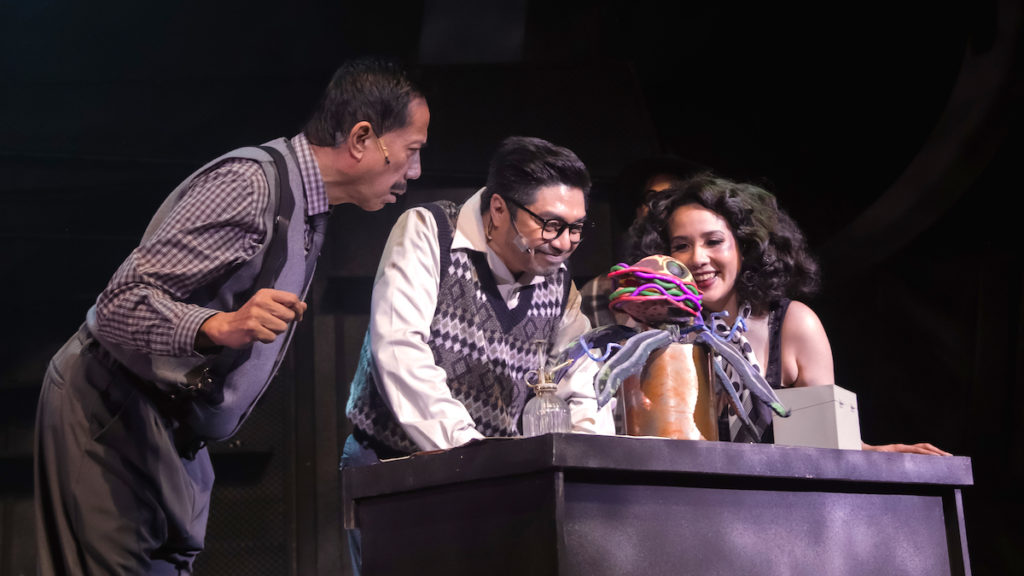I’m not a fan of Little Shop of Horrors. I often jest that there has to be a reason why it took two decades before it got a theatre on Broadway, and that I’m not willing to wait the same amount of time to find out. Written by Howard Ashman and Alan Menken, Gods of Disney’s Second Golden Age—the music, lyrics, and subject matter (As well as its ubiquity, mostly among high school theatre groups) had an acknowledged, popular charm that I personally couldn’t understand. But it was always there, being referenced, revived, and revered/reviled in equal measure.

It comes as no surprise, therefore, that when The Sandbox Collective announced their season which includes this musical, promising a fresh take on what could be considered an, ahem… antique, this writer was sufficiently intrigued at the prospect. After all, there’s only so much Tupperware-slash-vacuum-packed international productions one can take: One can’t ignore the potential of original musicals, or in this case, local adaptations of classic material.
The Sandbox Collective’s artistic and production teams should be applauded for creating a different take on a well-loved and popular piece.
The story of Little Shop of Horrors is firmly a textbook pulp horror classic, not unlike Dracula or Frankenstein’s Monster, popular literary fare that saw a resurgence in the 1950’s and 60’s. It opens at a small, non-descript, flower shop in the bad side of town. We are introduced to the trio of workers, the ornery old Mr. Mushnik , the questionably dressed (but very earnest) Audrey, and the mousy Seymour. We are given the low-down by a trio of urchins who serve as the play’s Greek chorus, providing much needed context on Audrey’s involvement in a toxic relationship with the sadistic dentist Orin, and Seymour’s fascination with odd botanical specimens. One of his latest projects was a strange plant he affectionately called Audrey II.
The problem is, Audrey II happens to have a taste for human blood and flesh (The fresher, the better!). Eventually, this leads Seymour to indulge Audrey II’s appetite for humans, with disastrous and tragic results.
Despite its seemingly simple plot, it is a complex comment on the ethics of the characters and the audience who watches it. As the play opens and we are made privy to the violent state of Audrey’s relationship with Orin, it is an easy justification to applaud the actions taken (or not taken) by Seymour since he is objectively horrible. As Audrey II consumes him, it absorbs his essence, making it stronger and more bloodthirsty by the day. When we get to the subsequent victims, the line the audience is asked to cross progressively gets further and further into much darker themes.
Nyoy Volante and Karylle Tatlonghari has firmly grounded this production, and is instrumental in what cements its legacy as one of the better local adaptations of this show.
Little Shop of Horrors is almost a direct adaptation of Goethe’s Faust, where the dramatic theme of the seduction of one moral man and it’s exponential effect on the world becomes the central conceit of the show. This is echoed in how the production design of the play echoes the all-seeing eye of God that’s ever watchful and ever present. The theme of corruption is also present in the subtle details of the costuming, where the people who are marked for destruction unconsciously carry the literal seeds of death on their persons in the form of small, fungal fruiting bodies all over their clothes, that eventually spread to every character in the show. Incidentally, Goethe’s first significant scientific work was centred on botanical development: Metamorphosis of Plants, which is more than a happy coincidence, I should think.
In the process of selling his soul to the devil, Seymour not only loses the single thing he loved most in the world, but also loses his morality in the process. At the end, upon coming to his senses, he, along with the audience, confronts the reality that the bargain has been struck, paid, and fulfilled, and as such we are left with little to do but watch as the world ends. It’s not a happy ending, not by a mile. It is a parable on the dangers of overwhelming greed and self-indulgence wrapped in Golden Age Disney songs, courtesy of Ashman and Menken.
The Sandbox Collective’s artistic and production teams should be applauded for creating a different take on a well-loved and popular piece. The cast turned in powerful performances that hit all the dramatic and comedic beats with astute aplomb. It’s not easy to avoid playing these characters as caricatures that most amateur productions are often wont to do: the play wouldn’t work otherwise. The depth of the story will be lost, and it becomes a grotesque cartoon. Thankfully, that wasn’t the case here.

Crowd favourite Markki Stroem assumes the role of Orin with just the right amount of douchebag swagger and deranged menace to make the role naturally despicable. Audie Gemora as Mr. Mushnik is the perfect mix of sweet and shady, going so far as emotional manipulation just so he doesn’t lose his meal ticket. OJ Mariano as Audrey II is delightful and does actually draw you in as the character grows stronger, more murderous, and more malevolent.
Nyoy Volante and Karylle Tatlonghari has firmly grounded this production, and is instrumental in what cements its legacy as one of the better local adaptations of this show. Volante so inhabits Seymour that even in the more quiet moments, in the smallest of gestures, he breathes life into the character. His vocal performance is on point during the Sunday matinee, and as with other adaptations of this material, if the audience does not emotionally connect and sympathise with him, the whole thing is bound to fall apart. Tatlonghari delivers a star turn as Audrey, and the author would be quick to add that this Audrey is fresh and exciting, and could definitely be where we truly see this artist shine. Her sensitive portrayal of this tragic character powers through even at an odd moment in the penultimate scene where she is somehow mortally injured. This moment was a head scratcher, to be perfectly honest, but Tatlonghari’s beautiful dramatic performance makes you forget about the clumsy direction. Almost.
For audiences who are not familiar with the original stage show, or the movie version, it does not matter if you have any prior knowledge of the material. Little Shop of Horrors is an accessible property, perfect for a fun night out, and it does have something for everyone. You might want your very young children to sit this one out despite its spun sugar soundtrack, unless you’re willing to explain the different organs of the human digestive system after the show. But as far as the level of craft and talent on display at the Maybank Performing Arts Theater, it requires no explanation. Just enjoy the ride.
Click here for more stories like “Little Shop of Horrors”. You may also follow and subscribe to our social media accounts: Facebook, YouTube, Instagram, TikTok, X, and Kumu.






















